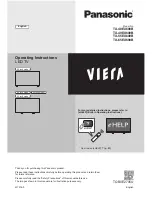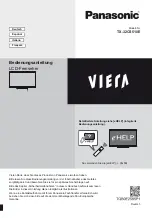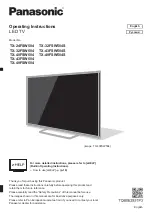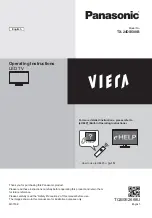
19
Converter
In the past, the word “converter” referred to a rotating machine consist-
ing of an electric motor driving an electric generator. This system was
used to change alternating current into direct current. Changing AC to
DC is also the purpose of this converter, but it is done in an electronic manner.
The converter consists of two parts:
1. The Rectifier
2. The Oscillator
Rectifier
The rectifier changes the 120Volts AC into DC using bridge rectifier D601.
The output of D601 is a pulsating DC waveform commonly called the
ripple. The 60 Hz ripple has a crest (high point) and a trough (low point).
C607 is the main filter capacitor that reduces the ripple amplitude by
charging during a crest and discharging to fill a void during the trough.
However, as the TV’s current demand increases, C607 cannot supply
the additional current to the TV during the trough. This is why there is a
higher AC ripple across the filter capacitor during a bright scene when
there is a greater current demand. This is shown in the chart below:
60 Hz Ripple at Main Filter Capacitor C607
TV Set OFF
0.8Vp-p across C607
TV Set ON – Dark screen
4Vp-p across C607
TV Set ON – Bright screen
6Vp-p across C607
Oscillator
The oscillator consists of two transistors, a main transformer, a PRT power
regulator) transformer (PRT)bias and protection resistors and capacitors.
When the oscillator runs, it produces a 180Vp-p square wave into the
main Power Input Transformer (PIT) T603/pin 6. The two transistors
(IC601) alternately turn ON and OFF to develop the square wave. The
operation of the oscillator consists of three parts:
1. A quiescent state
2. When the bottom transistor is ON and the top is OFF
3. When the bottom transistor is OFF and the top is ON
The Quiescent State
The oscillator starts when DC voltage from fusible resistor R606 is ap-
plied to the oscillator stage. Two initial current paths are taken toward
ground within the oscillator stage. The first current path places both
transistors in the IC601 package at the threshold of conduction to estab-
lish a quiescent state. This state places 85Vdc at IC601/2’s emitter.
First Current Path to Ground
Component
Input
Output
R606
R608 & R609
R608
R609
IC601-2
Base
Emitter
IC601-2
Collector
Emitter
R611 & R610
R611
R610
IC602-1
Base
Emitter / Ground
IC602-1
Collector
Emitter / Ground
Resistors R608, R609, R611 and R610 form a voltage divider string from
the +167Vdc supply to ground. The base – emitter junction of IC601/2
connects resistors R609 and R611. R610 is connected to ground by the
base – emitter junction of IC601/1.
The voltage at the junction of R609 and R611 is approximately half the
supply voltage because the resistors in the voltage divider string are the
same value. Therefore, before oscillation begins, there are 167Volts/2 =
83.5Vdc at IC601/1’s collector. At this time, the TV set consumes 40ma
AC (C614 removed to stop oscillation).
Bottom Transistor IC601-1 Turns ON
The second current path turns OFF transistor IC601-2 and turns ON tran-
sistor IC601/1, beginning the oscillator operation. This path passes
through several parts to ground:
Second Current Path to Ground
Component
Input
Output
R606
C614
T603 PIT
Pin 4
Pin 6
T602 PRT
Pin 1
Pin 2
R611 & R610
R611
R610
IC601-1
Base
Emitter / Ground
IC601-1
Collector
Emitter / Ground
Summary of Contents for CTV-25R1
Page 6: ...2 ...
Page 8: ...4 ...
Page 10: ...6 ...
Page 12: ...8 ...
Page 14: ...10 ...
Page 16: ...12 ...
Page 18: ...14 ...
Page 20: ...16 ...
Page 22: ...18 ...
Page 24: ...20 ...
Page 26: ...22 ...
Page 28: ...24 ...
Page 30: ...26 ...
Page 31: ...27 NOTES ...
Page 32: ...28 ...
Page 34: ...30 ...
Page 36: ...32 ...
Page 38: ...34 ...
Page 40: ...36 ...
Page 42: ...38 ...
Page 44: ...40 ...
Page 46: ...42 ...
Page 47: ...43 NOTES ...
Page 48: ...44 ...
Page 50: ...46 ...
Page 52: ...48 ...
Page 54: ...50 ...
Page 55: ...51 NOTES ...
Page 56: ...52 ...
Page 58: ...54 ...
Page 59: ...55 NOTES ...
Page 60: ...56 ...
Page 62: ...58 ...
Page 64: ...60 ...
Page 66: ...62 ...
Page 68: ...64 ...
Page 70: ...66 ...
Page 71: ...67 NOTES ...
Page 72: ...68 ...
Page 74: ...70 ...
Page 75: ...71 NOTES ...
Page 76: ...72 ...
Page 78: ...74 ...
Page 80: ...76 ...
Page 82: ...78 ...
Page 84: ...80 ...
Page 86: ...82 ...
Page 88: ...84 ...
Page 90: ...86 ...
Page 91: ...87 NOTES ...
Page 92: ...88 ...
Page 94: ...90 ...
Page 96: ...92 ...
Page 98: ...94 ...
Page 100: ...96 ...
Page 102: ...98 ...
Page 104: ...100 ...
Page 106: ...102 ...
Page 108: ...104 ...
















































